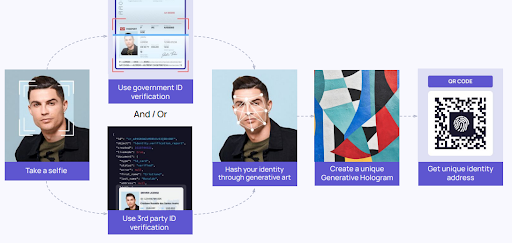How Will You Prove Your Identity in the Metaverse?
Amid the NFT craze, a growing number of digital artists have reported seeing their creative work being sold as NFTs by scammers and thieves

Derek Laufman is one such artist who learned from his social media fans that an impersonator was selling NFTs of his artwork on a leading marketplace.
It’s not uncommon in the digital world to download someone else’s art, tokenize it on the blockchain, and sell it to people around the world. In the case of Derek Laufman, customers who bought the NFTs from the impersonator had no way of verifying whether the seller was indeed Laufman.
Safeguarding your personal brand in the metaverse
With the rise of the metaverse, where almost everything is represented as NFTs on the blockchain, proving and protecting your identity will be crucial. That’s especially important if you are someone who attaches a lot of value to their personal brand, such as an artist, sportsperson, or corporate executive.
You don’t want to – and can’t afford to – be spoofed or impersonated in the metaverse. And if you have customers in the virtual world, they would want assurance that the seller is not a scammer impersonating you.
Thanks to the blockchain and NFTs, the metaverse is taking shape right before our eyes as a 3D, fully functional virtual universe that merges with our physical world. It is changing the way we work, play, shop, and socialize.
As people begin to spend more of their time and attention in the metaverse, they will be exchanging value with one another, a process where the ability to verify your identity would bring trust into transactions and keep scammers at bay.
Tokenized identity
The PhotoChromic protocol has come up with a solution to let users build and maintain a secure blockchain identity that works flawlessly in the metaverse. It aggregates your biometric proof of life, with government-backed identity verification and unique personal attributes, into an on-chain asset that you can use for blockchain-based identity verification and Web3 applications.
Your NFT identity is programmable, verifiable, universally addressable and digitally secured. It is tethered to your physical as well as digital assets.
Unlike passwords and passports that can be stolen, your identity on the blockchain is almost impossible to fake or steal, thanks to the immutability and robust security of the blockchain technology.
Using your non-transferable NFT identity, you can add provenance to the assets you create and transfer to others. It has a generative artwork seeded by your face. You can reveal the generative artwork, alongside certain other credentials, to someone for a period of time. Sportspeople or celebrities could keep the generative art identifiable. Others who want to stay pseudonymous
The generative artwork is created algorithmically using the passport image from the identification process and certain variables. The output is a unique and expressive image. You can work with the generative artist to try out different input variables and choose the resulting images based on how well you feel your own personality is expressed in the artwork.
PhotoChromic gives users total control over what details to share and with whom. The tokenized identity lives in your wallet just like any other NFT. PhotoChromic is initially built on Ethereum, but it aims to become a multi-chain protocol with a presence on Polygon, Cardano, Solana and other chains.
Conclusion
The metaverse is not something that lies in the distant future. It would undoubtedly transform a lot of things around us, including how we go about our day. Sportspeople, celebrities, and corporate executives keen on safeguarding their personal brands will feel the need to tokenize their identities on the blockchain. It will not only help them keep scammers away, but also enable them to easily provide verifiable proof of identification for KYC, financial services, asset management, buying and selling NFTs, and much more.










